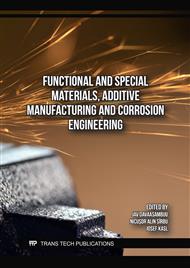p.3
p.21
p.31
p.39
p.47
p.57
p.63
p.71
Effect of Infill Density and Outer Shell on Flexural Behavior of FFF Printed PLA Samples
Abstract:
The Fused Filament Fabrication (FFF) process plays a crucial role in additive manufacturing (AM), therefore the optimization of certain parameters has a significant impact on the performance of 3D-printed components. In this study, the flexural behavior of Polylactic Acid (PLA) samples manufactured by FFF process is investigated. The influence of the infill density (ID) and the outer shell (OS) on the main physical and mechanical characteristics is studied in detail. The used IDs are 10%, 30%, 50%, 70%, and 90%, and the samples are manufactured with and without OS. All samples are manufactured with rectilinear infill pattern. The geometry of the samples and the experimental program follow the ISO 178 standard. The tests were performed at room temperature, with a test speed of 5 mm/min. The results indicate that main flexural properties (stiffness, strength, strain and fracture energy) are significantly superior in OS samples. Moreover, an increase in properties is obtained with the increase of the ID, regardless of the OS configuration. It was found that specimens without OS exhibited plastic deformation at all IDs, while those with OS demonstrated a quasi-brittle fracture pattern at IDs below 50%. Further analysis of the specific properties (specific strength and specific modulus) showed that an ID of 10% is optimal for 3D-printed structures with OS, while an ID of 90% is optimal for structures without OS. Thus, the importance of ID and OS parameters should not be neglected in the design of 3D printed structural components.
Info:
Periodical:
Pages:
39-46
Citation:
Online since:
November 2025
Authors:
Keywords:
Price:
Сopyright:
© 2025 Trans Tech Publications Ltd. All Rights Reserved
Share:
Citation:


